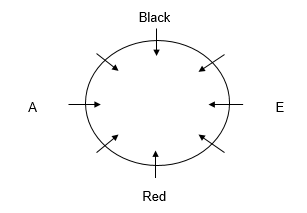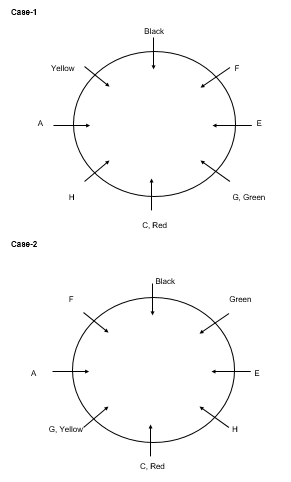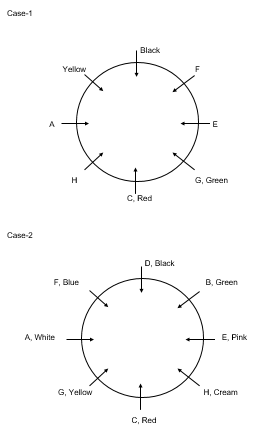Question
Which of the following is
true? Answer the questions based on the information given below. Eight persons A, B, C, D, E, F, G and H are sitting around a circular table facing inside but not necessarily in the same order. All of them likes different colour viz. Red, Green, Yellow, Blue, White, Black, Pink and Cream but not necessary in same order. Only one person sits between E and the one who likes Red. A sits second to the left of the one who likes Red. H is an immediate neighbour of C. C is not an immediate neighbour of A or E and he does not likes Black. E sits second to the left of the one who likes Black. Only three people sit between the one who likes Green and the one who likes Yellow. F sits second to the left of the one who likes Yellow. H does not likes Blue. The one who likes Blue is not an immediate neighbor of H. D sits on the immediate left of the one who likes Blue. The one who likes Pink sits on the immediate right of the one who likes Cream. Only two persons sit between G and the one who has likes Black. The one who likes Green sits second to the right of H.Solution
Only one person sits between E and the one who likes Red. A sits second to the left of the one who likes Red. If the one who likes Red sits at place no.1, then A sits at place no. 7 and E sits at place no. 3. E sits second to the left of the one who likes Black. So, the one who likes Black at place no. 5.  Only two persons sit between G and the one who has likes Black. From this statement, we will have two cases: G will sit either at place no. 2 or 8. H is an immediate neighbour of C. C is not an immediate neighbour of A or E and he does not like Black. The one who likes Green sits second to the right of H. C cannot sit at places no. 6, 5, 4, and 8. So, the only place left for him is place no. 1. As H is an immediate neighbour of C. So, H will sit either at place no. 8 or 2. The one who likes Green sits either at place no. 4 or 2. Only three people sit between the one who likes Green and the one who likes Yellow. So, the one who likes Yellow sits either at place no. 6 or 8. F sits second to the left of the one who likes Yellow. So, F sits either at place no. 4 or 6.
Only two persons sit between G and the one who has likes Black. From this statement, we will have two cases: G will sit either at place no. 2 or 8. H is an immediate neighbour of C. C is not an immediate neighbour of A or E and he does not like Black. The one who likes Green sits second to the right of H. C cannot sit at places no. 6, 5, 4, and 8. So, the only place left for him is place no. 1. As H is an immediate neighbour of C. So, H will sit either at place no. 8 or 2. The one who likes Green sits either at place no. 4 or 2. Only three people sit between the one who likes Green and the one who likes Yellow. So, the one who likes Yellow sits either at place no. 6 or 8. F sits second to the left of the one who likes Yellow. So, F sits either at place no. 4 or 6.  H does not likes Blue. The one who likes Blue is not an immediate neighbor of H. D sits on the immediate left of the one who likes Blue. The one who likes Pink sits on the immediate right of the one who likes Cream. Case 1 will get discarded as the one who likes Blue cannot sit at place no. 7 and 8. If the one who likes Blue sits either at place no. 4 or 3, then there is no place for D as D sits on the immediate left of the one who likes Blue In case 2, if the one who likes Blue sits at place no. 6, then D sits at place no. 5. The one who likes Pink and the one who likes Cream sit at place no. 3 and 2 respectively Only person left for place no. 4 is B. Only colour left for A is White.
H does not likes Blue. The one who likes Blue is not an immediate neighbor of H. D sits on the immediate left of the one who likes Blue. The one who likes Pink sits on the immediate right of the one who likes Cream. Case 1 will get discarded as the one who likes Blue cannot sit at place no. 7 and 8. If the one who likes Blue sits either at place no. 4 or 3, then there is no place for D as D sits on the immediate left of the one who likes Blue In case 2, if the one who likes Blue sits at place no. 6, then D sits at place no. 5. The one who likes Pink and the one who likes Cream sit at place no. 3 and 2 respectively Only person left for place no. 4 is B. Only colour left for A is White.  Case - 2 is the final arrangement.
Case - 2 is the final arrangement.
Which of the following traditional games is included by Indian Olympic Association in 37th National Games 2023?
Bali Jatra is the major Boita Bandana festival of a week celebrated in Cuttack from __________________ .
Which state in India has introduced the 'Nijut Moina' scheme to prevent child marriages by providing monthly stipends to girls pursuing higher education?
With reference to ‘Fiscal Deficit’, consider the following statements:
1.Fiscal deficit is calculated both in absolute terms and as a percent...
Consider the following statements about Pradhan Mantri Garib Kalyan Anna Yojana (PMGKAY):
1. Government recently extended the PMGKAY scheme for a...
Which of the following was an equivalent to a spy in an official capacity during the Paurava period?
The Performance Grading Index for Districts (PGI-D) is released by which of the following institutions?
Which portal has been launched by the Government of India for its complete fauna checklist?
Which Indian railway station received the 'Green Railway Station Certificate' in January 2023, achieving the highest Platinum rating?
Which airport was awarded the title "World's Best Airport" at the Skytrax World Airport Awards 2024?



